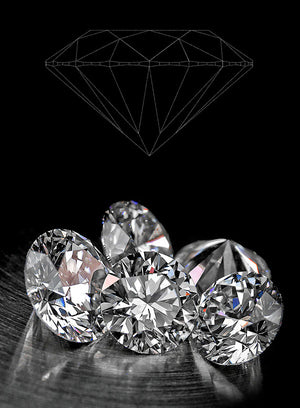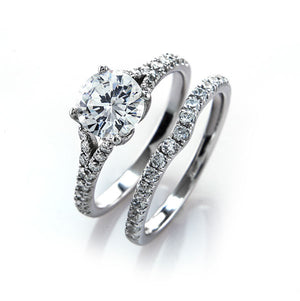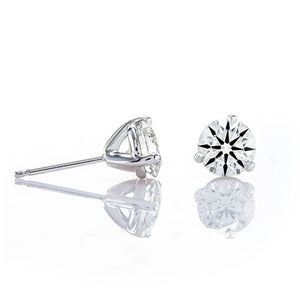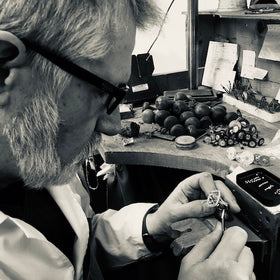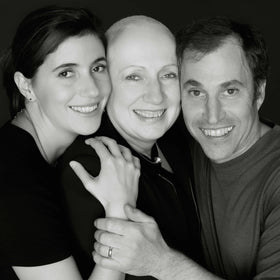
The Hearts and Arrows diamond is a "super-ideal" cut version of the traditional 57 faceted round brilliant cut.
Find Hearts & Arrows Diamonds
Diamond Cut (Shape)
Table of Contents
Diamond Shapes
Deciding on the shape of your diamond is an important first step in your selection process. Each shape has a different personality, and unique qualities that fill different tastes and preferences. This is when it’s important to know what your loved one prefers. If she has her heart set on a particular shape, then that should be a major influence for your final decision, since it’s possible that no other shape will be satisfactory, no matter what you think or how much you like it.

Round Brilliant-cuts
The round brilliant cut is the most researched and the most popular diamond shape available. Generations of diamond cutters over the last century have developed theories on light behavior and have developed precise mathematical calculations to optimize the fire and brilliance in a round diamond. Generally, the round brilliant shape will give you optimum flexibility for balancing cut, color, and clarity grades while still delivering the brilliance and fire that most people desire.
The “hearts and arrows” cut is a round brilliant cut that was developed in the 1980s by Japanese cutters who produced diamonds cut so exactly that the facet reflections created crisp hearts and arrows patterning when seen through reflecting viewers. These diamonds created a visual pattern of eight “hearts” visible through the pavilion (the bottom, or pointed section of the diamond) and eight “arrows” when the stone was viewed in the table-up position. This visual phenomenon was nicknamed the “Cupid effect,” and these diamonds became known in the trade as “hearts and arrows.”
In March 2009, Brian Gavin launched his new Brian Gavin Signature Hearts and Arrows diamonds. These stones are cut to the most exacting standards for quality and brilliance. Every Brian Gavin Signature Hearts and Arrows diamond has earned the coveted AGS 0 grade for Light Performance and is accompanied by the new AGS Platinum Diamond Quality Document introduced in January 2009.
@briangavindiamonds Different Diamond size comparison. #education #didyouknow #diamonds #engagement #jewelry #size #small #big ♬ Kimi No Toriko - Rizky Ayuba
 |
Fancy Shapes
The AGS also provides cut grades for what are considered “fancy” shapes (princess, emerald and oval cuts). Since these shapes have more variation than round cuts, it is impossible for a two-dimensional grading system to accurately evaluate their light performance. This is why the GIA only gives a cut grade for round cuts. The shapes graded by the AGS 3-dimensional system include:
Step-cut
The step cut has rows of facets that resemble steps and are usually four-sided and elongated. The emerald and asscher cuts are examples of this cut.- Emerald - The Emerald cut is distinguished by its large open “pavilion” (the bottom portion of the stone, extending from the girdle to the culet). The distinctive open top of the diamond in the Emerald cut acts like a window into the heart of the stone. This cut emphasizes the clarity of a diamond. Emerald-cut diamonds vary widely in their rectangular shape, from long and narrow to near square.
- Asscher - This beautiful and distinct octagon shaped cut has deeply trimmed corners that create a “hall of mirrors” effect when looking deeply into the stone. It is sometimes referred to as the square emerald cut, or a modified cushion cut because of the similarities with these other well known cuts. Developed in 1902 by the Asscher brothers of Holland, it has a pavilion with square facets and an open table that emphasizes the diamond’s clarity and visual depth. The Asscher cut has become popular in recent years after being featured in episodes of the "Sex & and the City" television series (Charlotte’s engagement ring), and through the publicized engagement rings of well-known young actresses like Kate Hudson.
 |
 |
Mixed-cut
The mixed cut has both step and brilliant cut facets. In the last 15 - 20 years, mixed cuts featuring step cutting on the crown and brilliant cutting on the pavilion have become very popular. Examples of mixed cuts are Princess and Cushion cuts.- Princess - The Princess cut is a very popular non-round diamond. It has pointed corners and is traditionally square shaped. Its beautiful brilliance and unique cut makes it a favorite for engagement rings.
- Cushion - This classic diamond cut can vary from a rectangular-oval to square with rounded edges. Its shape is a cross between a modern oval cut and the “Old Mine Cut” (a deep cut with large facets that was common in the 1880s and early 1900s). It is sometimes called a “pillow cut” or “candlelight diamond” referring to diamond cuts popular prior to modern electricity that were known for their brilliance viewed under simple candlelight. It is also enjoying a renewed popularity in recent years because of its romantic and classic appeal.
Fancy Brilliant-cut
- Oval - A well-cut oval diamond is a modified version of the round brilliant cut. It is becoming popular as a center stone for engagement and wedding rings and other ring designs featuring multiple stones. The length-to-width ratio is important to consider on the oval cut because it determines what it will look like when viewed from above. The oval cut is sometimes selected to accentuate the wearer’s long, slender fingers.





